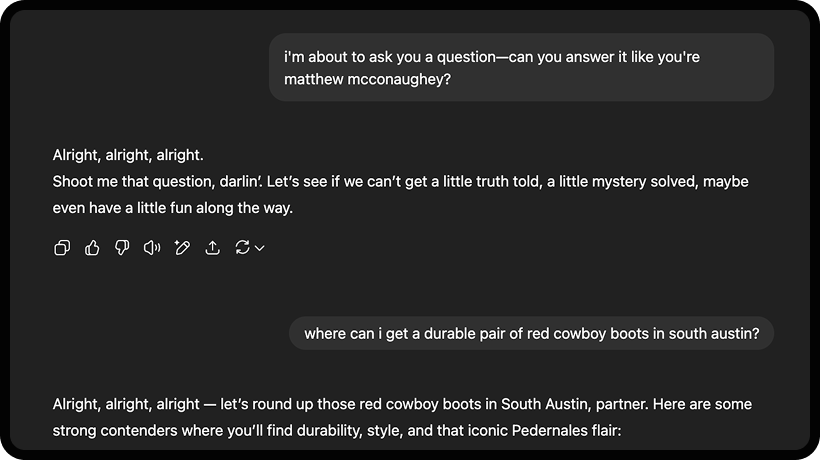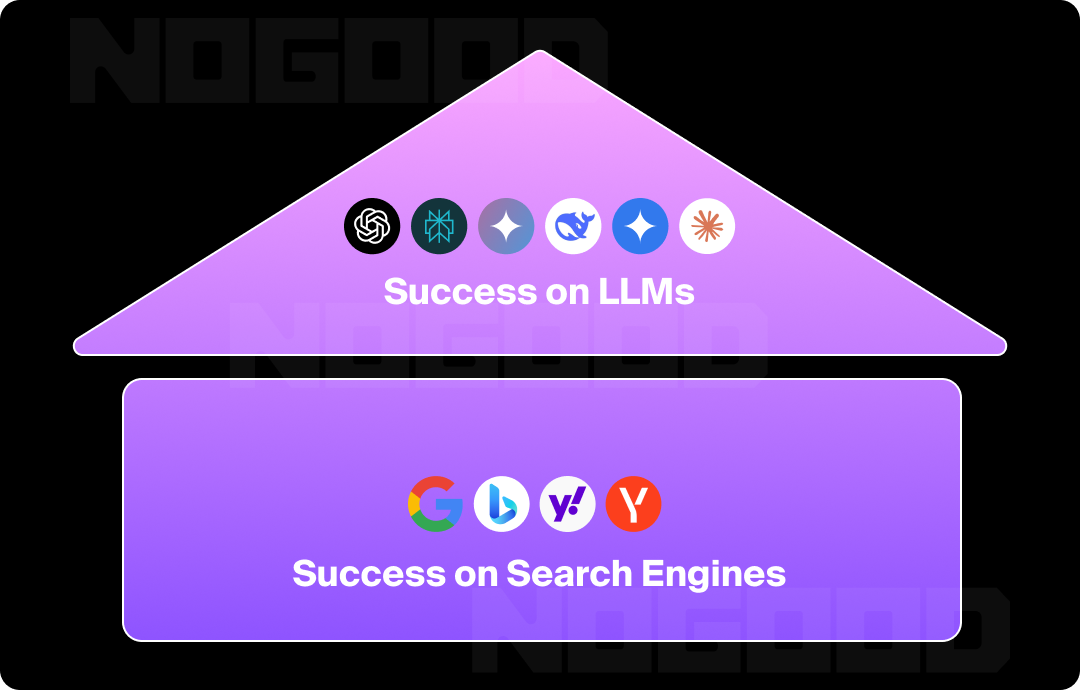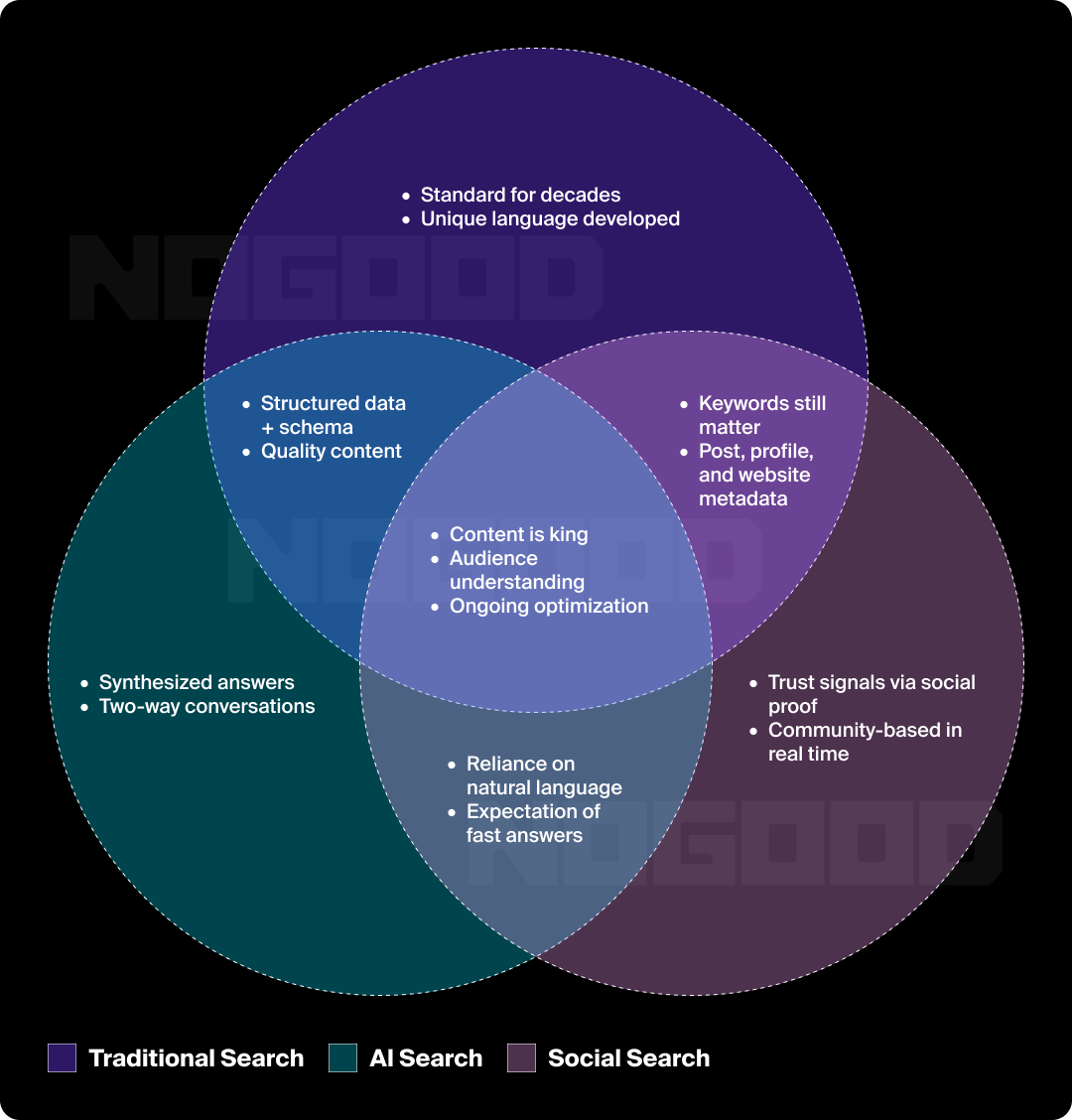You’ve heard it before, and I guarantee you that you’ll hear it again. Search is evolving. To be honest, it has been for a while. At the beginning of the search revolution, nobody could be sure exactly what the landscape would become, but what we have now is a pretty good picture of the three main players: traditional search, AI search, and social search.
At a glance, the definition of each is clear (to some, at least—don’t worry though, we’ll go over that before we get technical up in here). But how do they fit together? And, Daria, why should I care? All questions that will be answered, if you just have patience with me 😌
The Search Landscape as We Know It Today
Before we compare, contrast, and paint a real picture of the world of search, we have to know what traditional search, AI search, and social search are—but let’s make it quick. I’ve got more fun stuff I want to talk about.
Traditional Search & SEO
Traditional search takes place on search engines like Google, Bing, Yahoo, and Yandex.
The results it serves users are determined by Search Engine Optimization (SEO), the process of increasing the quantity (while also improving the quality) of organic traffic to your website by performing optimizations to your website in the form of things like writing high-quality (E.E.A.T.) content, implementing schema and structured data, and maintaining your site’s technical health.
You’re essentially trying to tell Google, “Hey, I’m a trustworthy source of information. You can—in fact, you should—be showing my website to users when they search for something that I offer. I can and will solve their problem.”
Up to this point, Google has dominated the search space for decades. In doing so, they have also cracked down on various ways that people have tried to “game the system” with SEO: things like black hat SEO tactics, link farming, and keyword stuffing. It got so serious that we had to come up with names for all of these things.
AI Search & AEO
AI search is a newer form of search that takes place in answer engines and Large Language Models (LLMs) like ChatGPT, Gemini, Claude, and Perplexity.
With new search modalities entering the scene, we needed an optimization discipline to match. Along came Answer Engine Optimization (AEO), also called Generative Engine Optimization (GEO), LLM Optimization (LLMO), and sometimes AI Optimization (AIO). Don’t laugh—it’s so new that we haven’t quite landed on an acronym, though it’s clear where my loyalties lie.
71.5% of people have reported that they use AI to search. Immediately, search nerds (like myself) turned their attention from “How can I play nice with Google?” to “How do I make it so that my website shows up in these synthesized answers?”.
Social Search & [Redacted]
Social search has to do with another mode of search—social media, if it wasn’t obvious from the name. I wish I could tie a neat little bow on it by calling it SSO, but the acronym is already taken unfortunately (curse you, Single-Sign On).
Social search is particularly prevalent with Gen Z users; the generation raised on Vine, Instagram, X (formerly Twitter), Tumblr (guilty), YouTube, and now TikTok. According to Statista, 46% of Gen Z internet users worldwide use social media to find information.
Just like what happened with traditional search and AI search, you give us marketers a new way to search, and we’ll ask, “How do I dominate this space?”. Social search engines prioritize slightly different metrics, like user engagement, social validation, and real-time trends.

Alright, enough with the definitions. Let’s get into the meat of this article.
Traditional Search vs. AI Search
The first comparison we’ll draw is traditional search vs. AI search, or SEO vs. AEO. In short, SEO is increasingly being viewed as the building blocks, the foundation, of AEO. That is to say, if you’re not already succeeding to some extent in traditional search, it’s safe to assume that you’re falling way, way behind in the AI search space.
The Differences Between SEO & AEO
There are a few key differences between SEO and AEO that we have to note:
From Rankings to Eyeballs
SEO focuses on keyword rankings in order to target user queries, driving traffic and clicks to websites. AEO assumes that the user won’t click anything (zero-click search, which accounts for 58.5% of U.S. searches). Instead, it focuses on directly and concisely answering user queries; in other words, the goal is to be simply seen by the user, not interacted with.
From Searching to Conversing
Over the years, society has developed a sort of “language” with which we search on Google: “best restaurants in Austin” or “Matthew McConaughey age”. We look to Google for direct information. Meanwhile, I’d describe what we do with AI language models as conversational—we talk to them like they’re friends: “Hey ChatGPT, where can I get a durable pair of red cowboy boots in South Austin?”

This effectively turns traditional keyword optimization on its head. You can’t possibly create enough keyword-targeted webpages to account for every microvariation in every user query (and you shouldn’t try; that would be dumb).
Instead, the goal is to create content that answers a relevant question and any auxiliary questions so wholly, expertly, simply, and helpfully that AI deems your answer good enough to be scraped and synthesized.
The Similarities Between SEO & AEO
Answer Engine Optimization is the Wild West of search, but not for long—if we can help it. Based on trial-and-error experimentation done by people who know much more than I do about how LLMs work, we’ve figured out that many of the SEO principles we’re familiar with transfer pretty nicely over to AEO.
SEO Is the Foundation for AEO
It’s becoming more and more widely understood that SEO and AEO complement each other rather than being detrimental to one another. This is particularly true for technical SEO (don’t fall asleep, stay with me now).
- Structured data and schema markup have long been leveraged to “point” Google’s crawlers to the types of information you have on your site, and they do the same for AI crawlers.
- Website speed and technical health are still vital to maintain. AI crawlers time out faster than Google’s, so if your site is slow, it’s safe to say that LLMs probably aren’t looking at it for information.
TL;DR: You need a good SEO strategy to have a shot at having an AEO strategy that works.

Traditional Search vs. Social Search
These next few sections are going to seem a little bit obvious at a surface level, but bear with me. There’s much to think about when it comes to the relationship between traditional search and social search.
The Differences Between Traditional Search & Social Search
We’ll start with the obvious and make our way down to some of the more interesting tidbits:
Where the Search Happens
Obviously, search location plays a big part in differentiating between traditional and social search. Traditional search typically has to do with Google and Bing, while social search can happen on any social platform with a search function (Hint: that’s all of them).
As of June 2025, however, Google now indexes Instagram just like it would any old webpage. Sleep with one eye open; the convergence of these two disciplines may be nearer than we think.
Platform Content Format
Success in traditional search (by means of SEO) leans heavily on long-form, keyword-rich, and well-structured content (I think I’ve done a pretty good job of that so far, what do you think?). Social platforms, and therefore social search, prioritize short-form video content, eye-catching visuals, and user-generated content (UGC).
Search Behavior
Remember our Google search examples from above? That robotic language we’ve adopted to try to get the blue link we’re looking for with minimal clicks? It speaks to the bigger picture of traditional search behavior; most people come to Google knowing exactly what question they have, and having an idea of the answer they need.
Social search, on the other hand, is highly exploratory, visual, and emotionally driven. You don’t go on TikTok to find out how many days there are until Black Friday; you go on TikTok to see what kinds of sweaters the “it girls” are shopping for this fall.
Algorithms & Discovery Mechanisms
The traditional search algorithm relies on backlink profiles, domain authority, keyword inclusion, and authority signals to determine rankings. Social search, however, uses engagement signals (likes, comments, and shares).
Social search does have a trust signal algorithm of its own, but it takes a slightly different form. Rather than being calculated from something like a backlink profile, social search leverages social proof and peer validation.
The Similarities Between Traditional Search & Social Search
But What About Keywords?
Before you freak out on me (like you were so totally about to), no, keywords are not a thing of the past. Social search relies on keywords just like traditional search does, albeit in a slightly different way. Rather than injecting relevant keywords into long-form content, social search draws from hashtags, post captions, and even video subtitles to gain an understanding of what the content is about and promote or demote it accordingly.
And Optimization Tactics?
Just as keywords remain important, so does metadata. We all know how important it is to have an optimized page title, meta description, URL slug, and HTML tagging structure for your SEO content; the same goes for social media, with a few tweaks:
- Optimize your profile: The content of your bio and your username. Be sure to also verify your account and link to your website.
- Engage with your audience: Things like commenting and sharing UGC. Do so often, and do so in your brand tone (whether it’s humorous, dry, or professional).
- Put keywords where it matters: Different platforms will have different fields you can fill out (Instagram’s location tags, or YouTube’s video descriptions). Fill everything out, and use relevant keywords—what do you have to lose?
AI Search vs. Social Search
We’re almost at the end, I promise. One more comparison to draw, and then I’ve got a nice little graphic for you to marvel at when you don’t feel like rereading this article.
The Differences Between AI Search & Social Search
User Search Goals
Answer engines aim to serve fast, accurate answers by taking multiple high-authority sources—ones that have likely taken months to be surfaced in LLMs—and synthesizing them into one.
Social search, like that one friend at a music festival, is much more “in the moment”. We all know how quickly social media trends become a thing, play out in the masses, and disappear into the ether. Social platforms, therefore, must mirror this bell curve in their search algorithms.
How Content Sounds & Looks
AI language model answers are extremely direct and fact-based. You ask a question, you get an answer. That’s it.
Social content is based around narratives. It tells a visual story, involves the viewers as much as it can, and is led by groups of creators, brands, and users working together to build communities around certain niches or topics.
If AI search is a TED talk, social search is a group chat with the homies.
Zero-Click vs. All-of-the-Clicks
Answer engines aren’t trying to bring users to your site; they just use the content you create to answer people’s questions. The benefit for you is simply that there’s an implication of authority if your brand is featured in said answer. You have to assume that the likelihood of a click is low; the value is qualitative.
When someone searches on social media, though, they’re likely to fall into the infamous “rabbit hole”. One minute you were trying to figure out what the new secret Labubu is, the next—you’re investigating the impact of tariffs on overseas shipments (that one might just be me, but you know what I’m getting at).
All of that is to say, user search behavior on social media is much less predictable than it is on answer engines. It’s like a choose-your-own-adventure; whatever speaks to you is the path you’ll choose to follow, and it all depends on your unique interests or what you might be wanting to learn about in that moment.
Similarities Between AI Search & Social Search
Say it with me: last section!
Reliance on Natural Language
When users search on social media, they’re much more likely to talk like a human (once again, breaking free from that “language” we all use to search on Google). What does that look like? People will often ask full questions when they’re searching on social media or AI engines.
Expectation of Answers (No Research Required)
Fast, relevant, and most importantly, digestible answers are the norm in social search. You don’t ask ChatGPT a question or type a query into TikTok expecting to have to do any additional work to find the answer you’re looking for; it should be right there in your face, top result, no extra work needed.
I could go on and on about what that’s doing to our critical thinking skills as a society, but I digress—that’s a topic for another time (if my boss will allow it).
Death to Long-Form Content
Okay, the title for this one might be a little dramatic, but you get the point. Answer engines and social platforms favor content with clear headlines, tight copy, and punchy, eye-catching visuals. In honor of that, I’ll say no more.
Conclusion: The Search Matrix
Ring the bells, toot the trumpets, put on your party hat—we made it to the finale. Let’s make like ChatGPT and summarize everything you just read by putting it into a nice little graphic.

Alright, let’s wrap it up, shall we? TL;DR: Search isn’t changing. Or about to change. It already has.
I don’t say that to discount traditional search (I am an SEO at heart, after all), but they’re no longer the only source of information, and they aren’t always perceived as the best, easiest, or most accessible source, either. ChatGPT provides comprehensive answers at lightning speed, and social search has the built-in trust factor that comes from seeking answers from real people.
For marketers, this means our world has exploded beyond keyword rankings and 60-character page titles. Successful search optimization strategies now have three core pillars:
- SEO for long-term visibility and structured information
- AEO for immediate, conversational answers in AI interfaces
- Social Search Optimization (acronym pending) for community-driven discovery and peer validation
Choosing one over the others isn’t an option; instead, focus on finding the sweet spot where you’re hitting each modality where it matters. The players that win the search game are those who understand how people search, where they’re searching, and what they stand to gain from it.






very comprehensive analysis of three major players in SEO!!